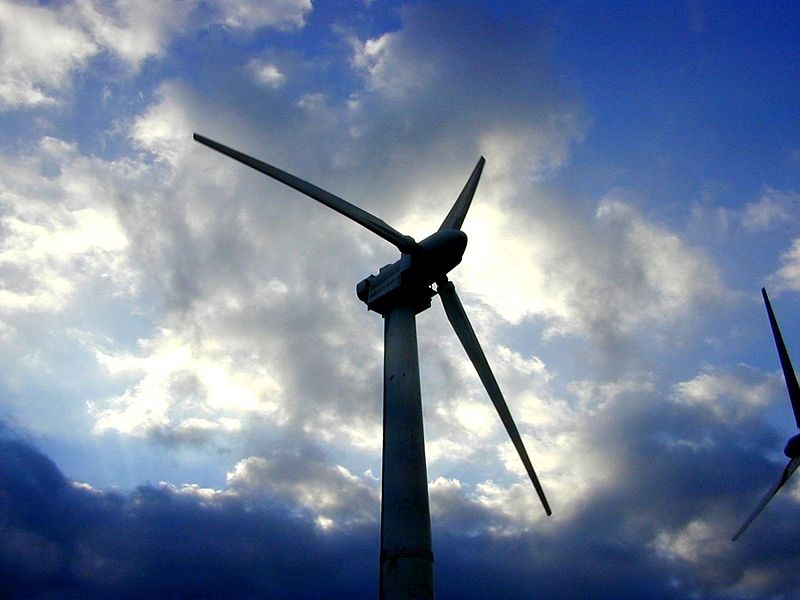By Brian Bienkowski

Report points to wind powered turbines as the way to clean air and jobs. Image: Wikimedia Commons
Thousands of jobs, millions of dollars and a more stable climate are possible if Illinois aggressively pursues clean energy, according to a report released by the Union of Concerned Scientists (UCS).
The peer-reviewed report, dubbed “Bright Future for the Heartland,” predicts what would happen if Midwestern states reached two goals: produced 30 percent of its electricity supply from renewables by 2030; and reduced power consumption 2 percent every year starting in 2015. The goals came from policy recommendations that were given to Midwestern state governors in 2009 by an advisory board.(“Energy Roadmap“)
In 2007, Illinois mandated that 25 percent of the state’s power supply be renewable by 2025, and power consumption must drop 2 percent annually. While a step in the right direction, the report claims the Prairie State stands to gain more by shooting for the Energy Roadmap targets.
By 2030, Illinois would add 8,400 jobs, lower energy bills by $4.7 billion and see $4.5 billion in new capital investment with stricter clean energy policies, according to the report.
The jobs would come from renewable energy manufacturing, installation, and maintenance – the kind of labor base abundant in Illinois.
“Few places in the world have the combination of a great renewable energy potential, a strong manufacturing base and the skilled workforce needed to realize that potential,” said Claudio Martinez, an energy analyst and report author. “And the Midwest is one of those places.”
Addressing job loss fears, the report found job creation in renewables would “far outweigh” any losses in traditional energy production. Money to produce coal and natural gas energy often flows out of state for extraction and transportation. According to a prior UCS study, utilities in the Midwest spent approximately 7.5 billion in 2008 importing coal.
Primary renewables for Illinois are wind and bioenergy. The report credits the state as a “leader in the Midwest’s rush to wind power,” but it remains a tiny fraction (1 percent in 2009) of electricity generated in the state.
Bioenergy is fuel from organic material, like wood and manure. While the practice remains nascent, the report recommends co-firing the organic material at existing coal plants to speed up the clean energy process and save money in new buildings.
Fears remain about the potential of both wind and bioenergy as energy sources. Wind energy can be costly and variable, while bioenergy relies on some materials that are nonrenewable.
Additionally, coal, as with most states, plays a big role in Illinois. Coal is an approximately $1 billion industry and mined in 12 counties throughout the state, according to the Illinois Department of Commerce and Economic Opportunity.
However, even with a tiny slice of the Illinois energy pie, wind projects already provide $18 million each year in local property taxes and $8.3 million annually for landowners leasing land for wind development, according to the report. And local institutions are researching sustainable ways to incorporate bioenergy into the energy landscape.
Authors left out any mention of Illinois nuclear energy, which accounts for over half the state’s energy, according to the Department of Energy. The focus was on new energy sources and, mainly, getting off coal, said Lisa Nurnberger, press secretary with UCS.
“A past (UCS) report modeled that nuclear would stay on at its current level until 2030,” Nurnberger said. “But new energy needs could be met by switching to renewables.”
The report cites wind and bioenergy as a complement to traditional sources and a way to keep pace with worldwide renewables investment. As policies vary throughout the Midwest, the region would benefit from working together, according to the report.
“It’s important that the region maintain momentum in making this transition because they could quickly lose ground to fast-growing clean energy economies in China, Germany and other countries,” said Steven Frenkel, director of UCS’s Midwest office.
This economic boost would be in addition to less pollution and global warming gases. By 2030, the Energy Roadmap goals would lower Midwestern carbon dioxide emissions by 130 metric tons annually — equivalent to yearly emissions from 30 typical-sized coal plants.
Findings for other Midwestern states mirrored those of Illinois — all estimates showing positive economic and environmental effects from investing in renewables. As the UCS is known for its environmental work, the report speaks conspicuously in economic terms — to a region still reeling from the recession.
As summed up simply by Frenkel:
“Adopting stronger clean energy standards can help transform the region’s economy.”
Editors note: This story first appeared in Mindful Metropolis and is reprinted with permission.